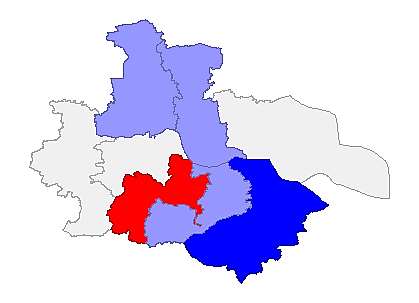论文总字数:18181字
目 录
1绪论 1
1.1研究背景及意义 1
1.2相关文献综述 1
1.2.1环境治理绩效评估方面的研究 1
1.2.2空间分布差异方面的研究 2
1.2.3文献综述述评 2
1.3研究思路与方法 3
2环境绩效评估指标和方法 4
2.1环境绩效评估概述 4
2.2环境绩效评估指标体系构建 4
2.2.1 构建指标概念框架 4
2.2.2 指标选取原则 4
2.2.3 指标体系确定 5
3扬子江城市群环境治理绩效评估研究 5
3.1数据的标准化处理 5
3.2主成分分析法的统计学检验 6
3.2.1因子分析的可行性检验 6
3.2.2提取公因子 6
3.2.3因子旋转 6
3.2.4计算因子得分及综合绩效指数 7
3.3结果分析与讨论 8
4扬子江城市群环境治理绩效水平空间差异分析 9
4.1研究方法 9
4.2 Moran’s I统计量描述 10
4.2.1空间权重矩阵 10
4.2.2全局Moran’s I指数及Local Moran’s I指数 10
4.3实证分析 11
5结论与对策 13
5.1主要结论 13
5.2 协同治理对策 13
5.3未来展望 14
参考文献 15
致 谢 17
附 录 18
扬子江城市群环境治理绩效空间差异研究
陈虹
, China
Abstract: There are many contradictions and problems in China's social development when the economy turns into the new normal. The governance of the ecological environment is an important issue that the government is currently facing. In this paper, the Yangtze River urban agglomeration is taken as the research object. In this study, I build a PSR-based index evaluation framework and use a principal component analysis method to quantify its environmental governance performance. Besides, this paper analyzes the spatial distribution characteristics of environmental governance performance with the Moran index. As a result, From 2012 to 2016, the environmental governance performance scores of the Yangtze River City Group have generally risen, and the level of environmental governance has been increasing year by year. However, the gap of environmental performance among cities has remained significant. In addition, the level of environmental governance performance in Nanjing and Zhenjiang has always been at the top class which means local environmental protection work has achieved remarkable results. Although the comprehensive performance level of environmental governance in Nantong has made great progress in the past five years, it has caused tremendous pressure on the environment due to the bad industrial structure, which leads to its poor performance. All government departments should strengthen the communication and connection in order to achieve a coordinated development of environmental governance. This paper also finds that there exists a certain spatial aggregation of the overall performance in urban agglomerations, and their spatial distribution shows a positive correlation, which is not a completely random distribution. Meanwhile, the high-high area and the low-low area present adjacent relationships in spatial position at the 5% level of significance. It is proposed that a cross-regional environmental governance consultation mechanism should be established to strictly divide the powers and responsibilities of environmental governance. Meanwhile, Firms should improve environmental behavior and actively change the way of end-of-pipe treatment. In addition, the public participation system ought to be completed in order to exert its function of being a supervisor.
Keywords: Performance Evaluation; PSR model; PCA; Moran Index
扬子江城市群环境治理绩效空间差异研究
1绪论
1.1研究背景及意义
近年来,水污染、土壤污染、大气污染等问题接连发生,严重影响到我国居民的健康生活。如何有效治理环境污染,缓解人与自然的矛盾,是当前政府面对的重要难题。十九大报告指出,“生态文明建设是中华民族永续发展的千年大计,要保障人民群众享有优质生态产品的权利”。2018年政府工作报告明确提出,要树立绿水青山就是金山银山的理念,着力治理环境污染,大力加强生态环境保护。这些都表明了国家高度重视生态环境。在过去的四十年中,我国的经济建设取得了举世瞩目的成就,但隐藏在其背后的是对环境、资源的极大破坏。高耗能、高排放的经济发展模式已难以为继,必须做出新的改变,调整今后经济发展的方向与走势,更加注重生态环境保护与治理工作,平衡经济发展与资源消耗的关系。
扬子江城市群作为江苏经济实力最强的地区,对其环境治理成效率先进行评估,总结其生态环境治理经验与教训,有利于为我省其他地区的环境治理工作提供有益的借鉴与参考。同时,本文还利用空间计量软件研究了扬子江城市群环境治理绩效的空间分布特征,有利于各地方政府充分了解本地区的环境治理进展,相互之间进行绩效水平的比较,从而明确差距来源,进一步调整工作方向,最终实现城市群环境治理的协同发展目标。
1.2相关文献综述
1.2.1环境治理绩效评估方面的研究
部分学者对环境绩效评估进行了探索。王婷等(2017)基于“压力-状态-响应”(PSR)模型和主题框架法对江苏省13个地级市的环境绩效指数进行了估算[[1]]。黄小卜等(2016)利用PSR模型创建了广西生态建设环境绩效评估指标体系,测算了2006至2013年生态建设的环境绩效指数 [[2]]。董战峰等(2016)采用主题框架法与“驱动力-压力-状态-影响-响应”(DPSIR)模型构建了环境绩效评价指标体系,对省级区域环境绩效的表现特征进行了拓展研究[[3]]。张亚斌(2014)等则依据SBM方向性距离函数和TOBIT模型对影响环境治理投资效率变动的因素进行实证检验[[4]]。田园宏等(2017)从城市污水处理这一角度出发,对污水治理绩效评价与环境绩效评价进行对比研究,指出了三个城市水污染治理绩效评价的研究方向[[5]]。Cookey(2016)等以湖北宋卡湖流域为例,建立了一套湖泊流域水治理绩效综合指数框架来评估湖泊水治理绩效[[6]]。
Liu(2017)等研究了深圳2007-2015年间的环境绩效管理体系,主要突出其政策因素(干部个人决策,上级政策,政府内部的相互作用)对环境治理绩效的影响,将环境治理绩效置于复杂的政治背景之下[[7]]。Chen(2017)等综合利用DEA方法和大数据理论,建立了考虑不良产出的SBM模型来衡量中国不同地区的环境效率[[8]]。Zuo(2017)等采用主题框架和DPSIR框架构建了复合指数模型用来评估环境治理绩效,并应用聚类分析方法将中国所有省级行政区分成3个子区域进行研究 [[9]]。Wang(2013)等利用改进的DEA模型测算了各行政区域从2000年到2008年的能源及环境效率 [[10]]。Ren(2018)等采用STIRPAT模型研究了中国东部,中部和西部地区的三种不同环境法规对其生态环境效益的影响程度[[11]]。Song(2012)等则对环境效益评估的相关文献进行了梳理与回顾,并详细阐述了小样本环境效率评价理论及不良产出的DEA方法[[12]]。以上学者对环境治理绩效评估方法进行了有效的补充。
1.2.2空间分布差异方面的研究
目前,国内外的许多学者对空间分析进行了广泛的研究。白永平(2012)等发现集聚经济在资源配置方面体现出显著的效用且城市化经济的资源配置效应远高于地方化经济[[13]] 。刘永伟(2015)等从省级层面对碳排放时空分布规律开展了调查研究,发现北京、江苏和浙江的地均碳排放强度呈现出“高—高”分布,青海、甘肃、宁夏、四川、和云南则呈现出“低—低”分布[[14]]。胡蒙蒙等(2016)分析了新疆2012年县域人均GDP空间分布关联性、人均GDP水平与城市化的空间关联性 [[15]]。贺冉冉(2017)等发现东部地区的AQI指数存在明显的季节波动性,且京津冀地区、长三角地区呈现出高度空间自相关性[[16]]。蒋天颖(2013)采用探索性空间数据和多元线性回归方法分析了区域创新水平差异及时空演化格局 [[17]]。Francesco等(2018)使用来自意大利国家统计研究院提供的环境数据,对意大利城镇中采用智能工具(ICT使用,智能交通,绿色创新,可持续治理等)的地区进行了空间差异研究 [[18]]。Yan(2017)等利用2003-2014年中国30个省的电力消耗数据,构建了基于不良产出的SBM模型来评估碳排放效率 [[19]]。
剩余内容已隐藏,请支付后下载全文,论文总字数:18181字
相关图片展示:





该课题毕业论文、开题报告、外文翻译、程序设计、图纸设计等资料可联系客服协助查找;


